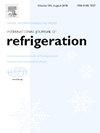Experimental study on serpentine-looped minichannel pulsating heat pipe heat exchanger with horizontal installation for full-year efficient heat recovery in air conditioning
IF 3.5
2区 工程技术
Q1 ENGINEERING, MECHANICAL
International Journal of Refrigeration-revue Internationale Du Froid
Pub Date : 2025-06-17
DOI:10.1016/j.ijrefrig.2025.06.019
引用次数: 0
Abstract
The heat recovery technology is considered to be one of the effective energy-saving means for buildings. The heat pipe, as a simple passive device with high thermal conductivity, has been widely used in heat recovery applications. Due to the opposite positions of cold and heat sources in winter and summer, vertical or inclined heat pipe heat exchangers can be difficult to operate in a certain seasonal condition. The horizontal heat pipe heat exchanger can solve this problem, but suffers from low heat transfer efficiency. The horizontal air-to-air finned heat exchanger is proposed based on the serpentine-looped minichannel pulsating heat pipe (SLMPHP) for efficient heat recovery in air conditioning. The SLMPHP heat exchanger is experimentally studied including the effects of the filling ratio, air flowrate and indoor and outdoor temperatures. The internal oscillation behaviors are also explored using Power Spectrum Density (PSD) method. Results show that the optimal range of the filling ratio for the SLMPHP is 45–65 % with greater oscillation intensity, and the maximum temperature effectiveness can reach 83.8 % in summer and 84.5 % in winter under horizontal installation, respectively. A thermal resistance map of SLMPHP heat exchanger is also presented for analysis and further prediction of its heat transfer performance to provide a guideline for the SLMPHP application in building heat recovery.
卧式蛇形环小通道脉动热管换热器全年高效热回收试验研究
热回收技术被认为是建筑节能的有效手段之一。热管作为一种简单、导热系数高的无源器件,在热回收中得到了广泛的应用。由于冬季和夏季冷热源位置相反,垂直或倾斜的热管换热器在一定的季节条件下难以运行。卧式热管换热器可以解决这一问题,但传热效率较低。提出了一种基于蛇形环路小通道脉动热管(SLMPHP)的卧式空气-空气翅片换热器,用于空调的高效热回收。对SLMPHP换热器进行了实验研究,包括填充率、空气流量和室内外温度对换热器性能的影响。利用功率谱密度(PSD)方法对其内部振荡特性进行了研究。结果表明:在振荡强度较大的情况下,SLMPHP的最佳填充率范围为45 ~ 65%;在水平安装条件下,夏季和冬季的最高温度效率分别可达83.8%和84.5%;并绘制了SLMPHP换热器的热阻图,对其传热性能进行分析和进一步预测,为SLMPHP换热器在建筑热回收中的应用提供指导。
本文章由计算机程序翻译,如有差异,请以英文原文为准。
求助全文
约1分钟内获得全文
求助全文
来源期刊
CiteScore
7.30
自引率
12.80%
发文量
363
审稿时长
3.7 months
期刊介绍:
The International Journal of Refrigeration is published for the International Institute of Refrigeration (IIR) by Elsevier. It is essential reading for all those wishing to keep abreast of research and industrial news in refrigeration, air conditioning and associated fields. This is particularly important in these times of rapid introduction of alternative refrigerants and the emergence of new technology. The journal has published special issues on alternative refrigerants and novel topics in the field of boiling, condensation, heat pumps, food refrigeration, carbon dioxide, ammonia, hydrocarbons, magnetic refrigeration at room temperature, sorptive cooling, phase change materials and slurries, ejector technology, compressors, and solar cooling.
As well as original research papers the International Journal of Refrigeration also includes review articles, papers presented at IIR conferences, short reports and letters describing preliminary results and experimental details, and letters to the Editor on recent areas of discussion and controversy. Other features include forthcoming events, conference reports and book reviews.
Papers are published in either English or French with the IIR news section in both languages.

 求助内容:
求助内容: 应助结果提醒方式:
应助结果提醒方式:


